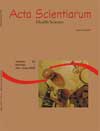<b>Epidemiological study of neonatal infections at the University Hospital of Londrina, Paraná</b> - DOI: 10.4025/actascihealthsci.v30i1.4386
Keywords:
nosocomial infection, neonatology, newborn, sepsis, neonatal mortality, Neonatal Intensive
Abstract
The greater susceptibility of neonates to infections results in higher rates of nosocomial infection (NIs) than in other patient populations. The objective of this work was to determine the frequency and profile of NIs in neonates associated to the main risk and death factors. A retrospective epidemiological study was conducted on neonates with NIs admitted to the neonatal sector at the University Hospital of Londrina, between 2001 and 2005. The mean annual rate of neonatal NI was 18.3% over the course of five years. The most frequent infections were pneumonia (46.0%) and sepsis (49.1%), which were related to a hospitalization period of over 60 days. The use of tracheal tubes and vascular catheters increased threefold the risk of sepsis. The tracheal tubes and vascular catheters increased the risk of death by 3.26 and 2.50 times, respectively. NIs contributed to 85.7% of deaths. The mortality coefficient was 15.8%.Downloads
Download data is not yet available.
Published
2008-07-24
How to Cite
Lopes, G. K., Rossetto, E. G., Belei, R. A., Capobiango, J. D., & Matsuo, T. (2008). <b>Epidemiological study of neonatal infections at the University Hospital of Londrina, Paraná</b> - DOI: 10.4025/actascihealthsci.v30i1.4386. Acta Scientiarum. Health Sciences, 30(1), 55-63. https://doi.org/10.4025/actascihealthsci.v30i1.4386
Issue
Section
Medicine
DECLARATION OF ORIGINALITY AND COPYRIGHTS
I Declare that current article is original and has not been submitted for publication, in part or in whole, to any other national or international journal.
The copyrights belong exclusively to the authors. Published content is licensed under Creative Commons Attribution 4.0 (CC BY 4.0) guidelines, which allows sharing (copy and distribution of the material in any medium or format) and adaptation (remix, transform, and build upon the material) for any purpose, even commercially, under the terms of attribution.
Read this link for further information on how to use CC BY 4.0 properly.























5.png)







